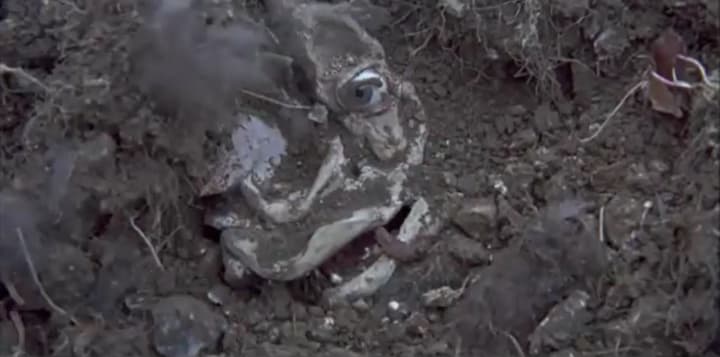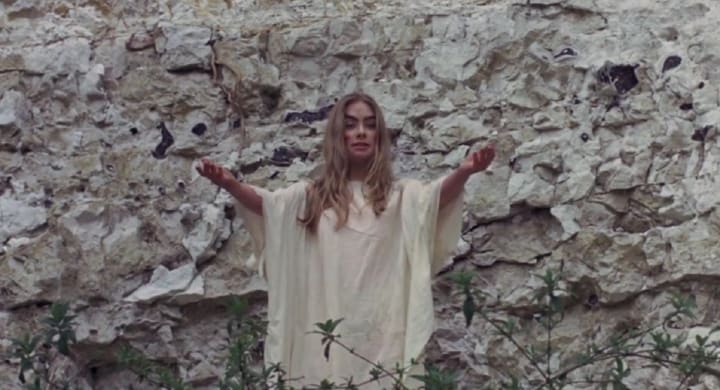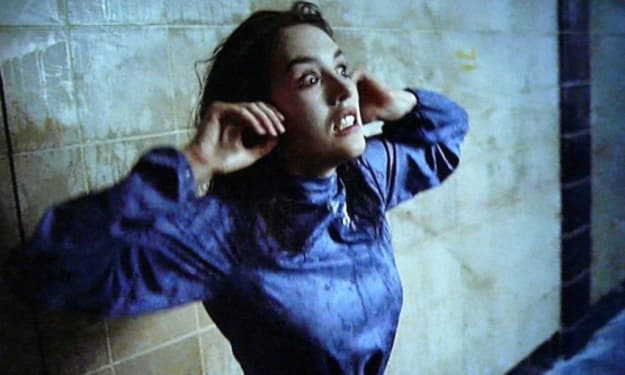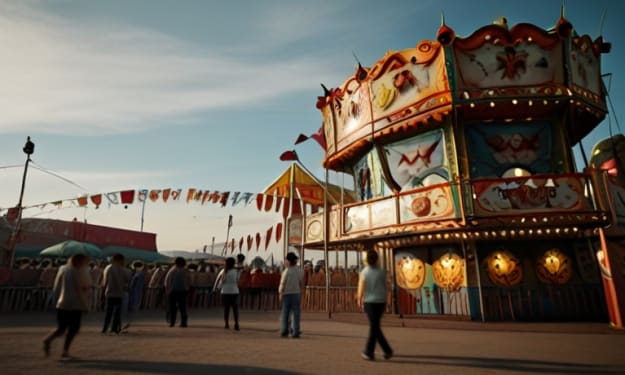PAUSE: Unearthing 'The Blood on Satan's Claw' (1971)
Nearly a staggering fifty years since it's initial release, this article takes an in-depth look at the forgotten British folk horror movie that shows an unnerving depiction of religious dissonance in a superstitious age left, by man, to rot.

Set during the uncertain times of pastoral early eighteenth century England, this period piece is folk horror at its finest. Often grouped in the same vein as 'The Wicker Man' (1973) and 'Witchfinder General' (1968), 'The Blood on Satan's Claw' packs a particularly memorable punch for those who have seen it. And its seeds of eeriness have been sewn in recent horror creations, such as 'A Field in England' (2013) and 'The VVitch' (2015). Despite this, 'The Blood on Satan's Claw' exists primarily these days as a movie dwelling mostly in cult status, with few testaments to its hidden brilliance. This is unfortunate, because, against the unfavourable odds of its low budget and aging special effects, 'TBOSC' is one of the few horror films to have truly unnerved me as of late.
Something about its setting in the mysterious realm of early modern England instills the thought and fear that people of the time truly could become lost in the psycho-religious hysteria of the era. The reassuring logic of secularisation and the ludicrous assessment of superstition is gone, as is our comfort blanket. The unfamiliarity with its chronological setting somehow allows you to become more immersed in its content. You provide the characters in the film with a pass for believing in such rituals and dogma, and therefore it becomes easy for the film itself to crawl under your skin.
The film begins when a boy, ploughing a vast green field, unearths what appears to be a grotesque set of bones, that of a decomposing corpse. The camera following the trail of the boy is set upon the ground, tilted upwards, as if we are watching from the point of view of the creature below ground waiting for its remains to be found. The very first scene brings about an uneasiness that sets the tone for the entire movie. The ominous camera angle, the steady approach of the unsuspecting farm boy and the repulsive skeleton with its beady eye intact are enough to make one feel uncomfortable from the very start.
It is commented on by the boy that the remains are not belonging to anything human. Instead they are oddly mutated and are accompanied by a strange fur that makes their origin untraceable. Yet the eye staring up from the ground is unmistakably humanoid. So what is it? To whom does it belong? The boy, who's name is Ralph, is understandably disturbed enough to inform the resident town judge. The judge is subsequently dismissive of the incident, deeming it superstitious hogwash, when they return to the site and find the bones and rotting carcass have mysteriously vanished.

Following this, the film shifts to centre around the escapades of Peter and Rosalind, two lovers set to be married who have come to visit the home of Peter's aunt. Funnily enough, this is also where the judge is residing while he passes through the town.
During their stay, strange occurrences strike the house, tormenting them. Consequently, Rosalind is driven mad by the demonic presence, and we are shown she has formed a grotesque, taloned claw as she is carried out of the house to be committed to an asylum.
Disturbed by this, Peter challenges the unknown force in the house's attic. Chaos ensues, and the image of a clawed beast dressed in a cloak briefly appears. Peter tries to fend it off, until he is discovered hacking his own hand off in delirium by the judge.
Meanwhile, the children and adolescents of the town are undergoing a transformation. A boy is murdered by a group under the guise of a game of blind man's bluff. Child after child becomes embroiled in this satanic scheme, and, eventually, a leader for this sinister group of teens emerges. Angel Blake, an outwardly innocent girl vehemently defended against accusations of sexual promiscuity by her attentive father, becomes the instigator for the actions of this demonic sect.
As the film progresses, we see the fruits of Angel's labours take place in an utterly chilling derelict church. Its stone walls, seemingly crumbling before our eyes, give way to the undergrowth and looming trees of the film's beautiful rural, underdeveloped setting.
Many strange encounters happen in this ritualistic arena during the film's duration, under the name of its principal antagonist: the demon named 'Behemoth'. One of these encounters is an uncomfortable and graphic rape of one of the village girls, overseen by Angel. In the name of Behemoth, the sect is trying to restore his body with the parts scattered beneath the village soil. All the while, the judge is trying to read up on the nature of witchcraft and demonology, despite his misgivings about its preposterous nature,
TBOSC is a small masterpiece of insidious storytelling. While it is not as polished as its sister films in production value, it eclipses both 'Witchfinder General' and 'The Wicker Man' for pure eeriness and scares. These are not scares in the conventional sense we've come to be burdened with; they are not jump-scares. Rather, the real scares in this movie are its unsettling imagery, uncomfortable rhythm and tone, and its overarching sense of something grave and terrible impending on its inhabitants. This unsettled feeling that permeates throughout the film is helped by its performances, most principally the role of Angel.
The ironically-named Angel is Christ's antithesis with her lurid behaviour and woven halo of leaves and flowers. She is a pagan Christ bestowed with a crown of thorns, sacrificing her innocence to her master's cause, and a follower of the earth through which the inverted Pan Behemoth is embodied. Angel is played by Linda Hayden, who oozes with the ominous evil of a demon priest eager to do their master's bidding. Her pale eyes beneath a pair of strong brows and curtains of long blond hair betray her innocent exterior with a malicious nature that is conveyed so brilliantly by the actress. She seems to almost float about the stone ruins of the church and is scarily absorbed in her mission to bring Behemoth to full power. Hayden is able to convey the unshakable pull Angel feels for this demonic force, as if hypnotised by it or its promise of security and belonging. Rather appropriately, on the commercial poster for TBOSC, we see an artist's rendition of Behemoth holding a nude Angel beneath his cloak. This brilliant contrast of the grotesque and demonic poisoning the archetypal figure of innocence is one of the film's most successful images: the demon imprisons the nymph and enchants her to do his bidding.

Another performance which ramps up the fear in this forgotten masterpiece is that of Wendy Padbury, who does an excellent job as the wide-eyed Cathy subject to assault and torture by the sect. Despite her initially shrill and over-energetic nature, Padbury is able to evoke a gut-wrenching reaction of sympathy for this sweet little girl who is unsuspectingly tricked by the peers she thought she could trust into undergoing an abhorrent ritual.
Members of the village and the demonic sect aside, Patrick Wymark is ultimately the unsuspecting hero of this tale, with his initial stand-offish persona and dismissive, stubborn authority-figure trope causing us to toss him away as a potential protagonist. But, throughout the film, he slowly emerges into the role of the unwilling hero, forced to reconsider his beliefs if he is to stop the malevolent force seizing the impressionable minds of the village youth and causing them to murder. Stoic, resolute and quietly courageous, Wymark's unnamed judge is a presence throughout the film that keeps you tethered to the shore of sanity. His appearances, though dry and often disheartening for other characters, impress a sense of reassurance that the nightmare we are witnessing can be fought.
In addition to its cast, the film's main star is its setting, helped by Piers Haggard's unconventional direction. With the location of its delapidated church in Oxfordshire, the film's vast greenery and endless forest makes the village feel exposed to danger, even vulnerable. Yet it also isolates them. There is seemingly nothing for miles, so internally, they are damned if Angel's sect is to become successful in bringing Behemoth to power. Additionally, the church ruins, while casting an obviously creepy feel over the film, are an ironic take on the sanctity of the Christian religion. Once holding a congregation of believers, this ruined church is set upon by Behemoth and his followers as a perverted version of a house of worship. Therein lies TBOSC's disturbing, irksome brilliance.
And, all the while, Haggard's direction delivers oodles of visual trickery that sets the implication of film crawling and wriggling under one's skin. Whether it be the wide, still shots of the greenery surrounding the isolated village making one feel gloomy and vulnerable, or the uncomfortably close shots of the ritualistic rape that make one feel as though they are in the midst of its bloody, violent fray, Haggard knows how to tap into your rawest emotions, and accelerate our innermost responses to what is happening onscreen.
Overall, TBOSC is a forgotten masterpiece that is dripping with the typical low-budget feel of '70s horror B-movies, but somehow emerges victorious among all of the era's folk horror creations in its ability to scare and unnerve. Much like its more popular successor 'The Wicker Man', it shows the frightening mindset of a group of people who have bought into a particular system of belief. Indeed, Behemoth doesn't show up in his full form until the film's denouement, so for the most part we are watching people (namely children) act on his behalf. We see them torture, maim and murder, with no demon in sight. Factor out the demonic carcass beneath the earth and the strange clawed creature attacking people in attics, and we are left with a frightening insight into the hysteria that could seep into the minds of an isolated community overrun with superstition and dogma; a situation not too far removed from the Salem witch trials or East Anglian witch hangings. It is chilling, to say the least.
Despite its less than renowned status, TBOSC should be watched by all horror fans, if only for its satanic themes and shock-value. Though its most eyebrow-raising scenes are not without substance or purpose, the film certainly is a grotesquely entertaining saga, but with an underlying creepiness that should leave its claw-marks on the inside of your mind for quite some time.
About the Creator
Dani Buckley
Pennings of the dark and cinematic. Phantasmagoria abound.






Comments
There are no comments for this story
Be the first to respond and start the conversation.